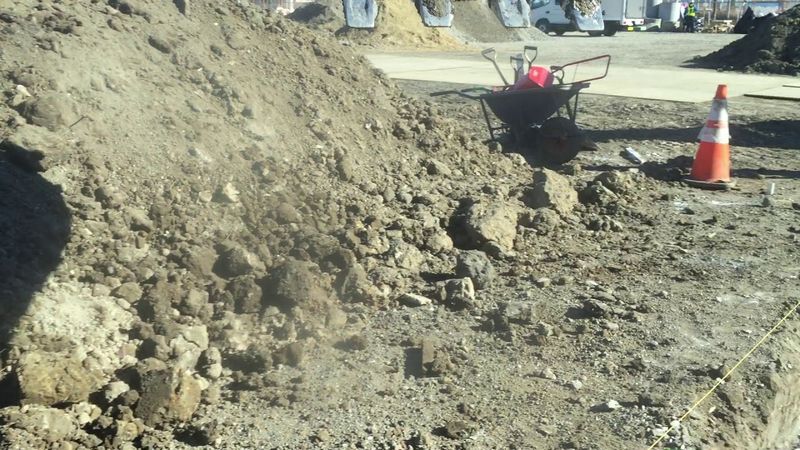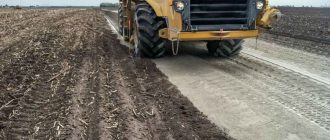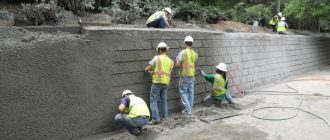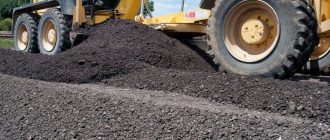
An Overview of Chemical Soil Stabilization Techniques for Enhanced Soil Performance
Chemical soil stabilization is a technique used to improve the engineering properties of soil, making it more suitable for construction purposes. It involves the addition of chemicals to the soil, which react with the soil particles to enhance its strength, stability, and durability.
This method is commonly used in civil engineering projects, such as road construction, building foundations, and slope stabilization. Chemical soil stabilization can be a cost-effective solution, as it can be applied to a wide range of soil types and can reduce the need for costly excavation and replacement of unsuitable soil.
There are various chemicals that can be used for soil stabilization, including lime, cement, fly ash, and chemical additives. These chemicals work by altering the physicochemical properties of the soil, such as its pH, moisture content, and plasticity. The addition of these chemicals can improve the soil’s load-bearing capacity, reduce settlement, and increase its resistance to erosion.
Chemical soil stabilization offers several advantages over other methods, such as mechanical stabilization or soil replacement. It can be used to treat a wide range of soil types, including cohesive and non-cohesive soils, and can be applied in both wet and dry conditions. Additionally, chemical stabilization can be completed quickly, with minimal disruption to the surrounding environment.
In conclusion, chemical soil stabilization is a valuable technique for improving the engineering properties of soil. By adding chemicals to the soil, its strength, stability, and durability can be enhanced, making it more suitable for construction purposes. This method offers several advantages over other stabilization techniques and can be a cost-effective solution for various civil engineering projects.
What is Chemical Soil Stabilization?
Chemical soil stabilization is a technique used to improve the properties of soil in order to enhance its strength and durability. This process involves the addition of chemicals to the soil, which react with the soil particles to create a more stable and compacted material.
The chemicals used in soil stabilization can vary depending on the specific needs of the project. Common chemicals used include lime, cement, and fly ash. These chemicals work by binding the soil particles together, increasing the cohesion and reducing the plasticity of the soil.
Chemical soil stabilization is commonly used in construction projects to improve the load-bearing capacity of the soil. It can be used to stabilize weak or expansive soils, making them suitable for building foundations, roads, and other structures.
One of the main advantages of chemical soil stabilization is its cost-effectiveness. Compared to other methods, such as mechanical soil compaction, chemical stabilization is often more economical and time-efficient. It also allows for greater flexibility in design, as the properties of the soil can be tailored to meet the specific requirements of the project.
Overall, chemical soil stabilization is a valuable technique for improving the engineering properties of soil. By enhancing the strength and durability of the soil, it helps to ensure the long-term stability and performance of construction projects.
The Process of Chemical Stabilization
Chemical stabilization is a process used to improve the engineering properties of soil by adding chemical agents. This process involves the use of different chemicals to modify the soil’s composition and enhance its strength, durability, and resistance to moisture.
The first step in the process of chemical stabilization is conducting a thorough assessment of the soil’s properties and characteristics. This includes testing the soil’s moisture content, particle size distribution, and plasticity index. This information is essential for determining the type and amount of chemical agents needed for the stabilization process.
Once the soil assessment is complete, the next step is selecting the appropriate chemical agents for stabilization. There are various types of chemical agents available, including lime, cement, fly ash, and polymers. The choice of chemical agent depends on the specific soil conditions and the desired engineering properties.
After selecting the chemical agents, they are thoroughly mixed with the soil. This can be done using mechanical mixing equipment, such as a pugmill or a cement mixer. The mixing process ensures that the chemical agents are evenly distributed throughout the soil, providing uniform stabilization.
Once the chemical agents are mixed with the soil, the soil is compacted. Compaction is necessary to achieve the desired density and stability. This can be done using compaction equipment, such as a vibratory roller or a plate compactor. The compaction process helps to create a solid and stable base for construction activities.
After compaction, the stabilized soil is allowed to cure. Curing is a process that allows the chemical agents to react with the soil and form bonds, resulting in improved strength and durability. The curing time depends on the type of chemical agents used and the environmental conditions.
Once the soil is fully cured, it is ready for use in construction projects. The stabilized soil can be used as a base for roads, foundations, and other structures. It provides enhanced load-bearing capacity, improved resistance to erosion, and increased durability.
The process of chemical stabilization involves assessing the soil’s properties, selecting appropriate chemical agents, mixing them with the soil, compacting the soil, allowing it to cure, and using the stabilized soil for construction purposes. This process helps to improve the engineering properties of soil and make it suitable for various construction applications.
Chemical Stabilization of Clay Soil
Chemical stabilization is a widely used method for improving the engineering properties of clay soil. Clay soil is known for its high plasticity, low strength, and poor load-bearing capacity, which can pose significant challenges for construction projects.
Chemical stabilization involves the addition of certain chemicals to clay soil to alter its physical and chemical properties. These chemicals can help reduce the plasticity and improve the strength and stability of the soil, making it suitable for construction purposes.
One commonly used chemical for soil stabilization is lime. Lime reacts with clay minerals in the soil and forms stable compounds that improve the soil’s strength and reduce its plasticity. Lime stabilization can also increase the soil’s resistance to moisture and improve its durability.
Cement is another chemical commonly used for clay soil stabilization. Cement reacts with the clay minerals and forms a cementitious matrix that enhances the soil’s strength and load-bearing capacity. Cement stabilization is often used for stabilizing clay soils in road construction projects.
In addition to lime and cement, other chemicals such as fly ash, bitumen, and polymers can also be used for clay soil stabilization. These chemicals have different mechanisms of action and can be selected based on the specific requirements of the project.
Chemical stabilization of clay soil offers several advantages. It can significantly improve the soil’s engineering properties, including its strength, stability, and durability. It can also reduce the soil’s susceptibility to shrinkage and swelling due to moisture changes, which is a common problem in clay soils.
However, chemical stabilization also has some limitations. The effectiveness of the stabilization process depends on factors such as the type and composition of the soil, the type and dosage of the chemical, and the mixing and curing procedures. Therefore, proper laboratory testing and field trials are essential to determine the optimum chemical dosage and treatment procedure.
In conclusion, chemical stabilization is a valuable technique for improving the engineering properties of clay soil. By using appropriate chemicals, such as lime or cement, the plasticity can be reduced, and the strength and stability of the soil can be enhanced. However, careful consideration should be given to the specific requirements of the project and proper testing and trials should be conducted to achieve the desired results.
Understanding How Chemical Stabilization Works
Chemical soil stabilization is a technique used to improve the engineering properties of soil by introducing certain chemical agents. These agents chemically react with the soil particles to enhance their strength, stability, and durability.
The process of chemical stabilization involves the following steps:
- Soil Testing: Before applying any chemical agents, it is important to carry out a thorough analysis of the soil to determine its composition and properties. This helps in selecting the appropriate chemicals for stabilization.
- Chemical Selection: Based on the soil test results, suitable chemical agents are chosen. These can include cementitious materials, lime, fly ash, or other additives that have the ability to react with the soil particles.
- Application: The selected chemicals are then mixed with the soil using mechanical or manual methods. The aim is to achieve a uniform distribution of the chemicals throughout the soil mass.
- Chemical Reaction: Once the chemicals are mixed with the soil, a chemical reaction takes place. This reaction causes the soil particles to undergo physical and chemical changes, resulting in improved engineering properties.
- Compaction: After the chemical reaction has occurred, the stabilized soil is compacted to achieve the desired density. This helps in further enhancing the strength and stability of the soil.
- Curing: The stabilized soil is then allowed to cure for a specific period of time. This allows the chemical reaction to fully develop and the soil to gain its maximum strength.
Chemical stabilization offers several advantages over other soil improvement techniques. It is cost-effective, requires less time and labor, and can be used to treat a wide range of soil types. Additionally, it allows for the reuse of existing soil, reducing the need for excavation and disposal.
In conclusion, chemical stabilization is a proven method for improving the performance of soil in construction projects. By understanding how chemical stabilization works and following the proper procedures, engineers and contractors can achieve stronger and more stable soil conditions, leading to safer and more durable structures.
Suitable Soil Types for Chemical Stabilization
Chemical soil stabilization is a technique used to improve the engineering properties of soil and make it suitable for construction purposes. However, not all soil types are suitable for chemical stabilization. The effectiveness of chemical stabilization depends on the soil’s composition and characteristics.
Here are some soil types that are suitable for chemical stabilization:
| Soil Type | Description |
|---|---|
| Clay | Clay soils have small particles that can be easily manipulated with chemical additives. Chemical stabilization can help reduce the plasticity and improve the strength and load-bearing capacity of clay soils. |
| Silt | Silt soils have medium-sized particles that can benefit from chemical stabilization. By adding stabilizing agents, the cohesion and stability of silt soils can be increased, making them suitable for construction. |
| Sand | Sand soils have large particles that may not require chemical stabilization. However, in certain cases where sand soils are loose or have poor compaction properties, chemical stabilization can help improve their strength and stability. |
| Gravel | Gravel soils have coarse particles that generally do not require chemical stabilization. However, in cases where gravel soils are poorly graded or have low cohesion, chemical stabilization can be used to enhance their properties. |
It is important to note that the suitability of soil types for chemical stabilization may vary depending on the specific project requirements and conditions. Soil testing and analysis should be conducted to determine the appropriate chemical stabilization methods and additives for each soil type.
Overall, chemical soil stabilization offers a versatile solution for improving the engineering properties of various soil types, making them suitable for construction and other applications.
Benefits of Chemical Soil Stabilization
Chemical soil stabilization offers a range of benefits that make it a popular choice for various construction and infrastructure projects. Some of the key benefits include:
1. Increased Load-Bearing Capacity: Chemical soil stabilization improves the load-bearing capacity of the soil, allowing it to support heavier structures and equipment. This is especially beneficial in areas with weak or unstable soils.
2. Enhanced Durability: By stabilizing the soil, chemical additives can increase its durability and resistance to erosion, weathering, and other environmental factors. This helps to extend the lifespan of structures and reduces maintenance costs.
3. Improved Soil Workability: Chemical soil stabilization can improve the workability of the soil, making it easier to excavate, compact, and shape. This is particularly useful in construction projects where the soil needs to be manipulated to meet specific engineering requirements.
4. Cost Savings: Chemical soil stabilization can often be a more cost-effective solution compared to traditional soil stabilization methods. It can reduce the need for extensive excavation and replacement of unsuitable soil, resulting in significant cost savings for the project.
5. Time Efficiency: Chemical soil stabilization can be a faster process compared to other soil stabilization methods. It allows construction projects to proceed more quickly, reducing overall project timelines and minimizing disruption.
6. Environmental Benefits: Chemical soil stabilization can help to reduce the environmental impact of construction projects. By stabilizing the soil, it minimizes the need for soil excavation and disposal, reducing the amount of waste generated.
7. Versatility: Chemical soil stabilization can be used in a wide range of soil types and conditions, making it a versatile solution for various construction projects. It can be tailored to meet specific project requirements, ensuring optimal results.
Overall, chemical soil stabilization offers numerous benefits that make it a valuable technique for improving the performance and stability of soils in construction projects.
Improved Soil Strength
Chemical soil stabilization techniques are commonly used to improve the strength of soil. By treating the soil with certain chemicals, it becomes more stable and less susceptible to deformation. This is especially important in construction projects where the soil needs to support heavy loads.
One commonly used chemical for soil stabilization is lime. Lime is added to the soil to increase its strength and reduce its plasticity. When lime is added, it reacts with the soil particles and forms stable compounds that bind the soil particles together. This increases the cohesion of the soil and improves its overall strength.
Another chemical commonly used for soil stabilization is cement. Cement is mixed with the soil to create a solid and stable mass. When cement reacts with water, it forms a hard and durable material that binds the soil particles together. This improves the shear strength of the soil and makes it more resistant to deformation.
In addition to lime and cement, other chemicals such as fly ash, bitumen, and polymers can also be used for soil stabilization. These chemicals work by altering the soil’s properties, such as its moisture content and particle size distribution, to improve its strength.
Overall, chemical soil stabilization techniques are an effective way to improve the strength of soil. By treating the soil with certain chemicals, it becomes more stable and less prone to deformation. This is crucial in construction projects where soil strength is vital for the stability and longevity of structures.
Enhanced Workability
Chemical soil stabilization techniques can greatly enhance the workability of soil, making it easier to handle and manipulate during construction projects. By treating the soil with specific chemicals, such as lime or cement, the soil’s plasticity and cohesion can be improved, resulting in a more manageable material.
Enhanced workability allows for better compaction, leveling, and shaping of the soil, which is especially beneficial in the construction of roads, embankments, and foundations. It also reduces the risks associated with working with unstable or loose soil, such as soil erosion, settlement, or shifting.
Moreover, the enhanced workability provided by chemical soil stabilization techniques can help reduce the amount of water required for construction activities. By increasing the soil’s ability to retain moisture, less water is needed to achieve the desired consistency, saving both time and resources.
Overall, the enhanced workability achieved through chemical soil stabilization techniques improves construction efficiency, reduces project costs, and enhances the long-term stability and performance of the soil. It is a valuable solution for achieving optimal soil conditions in various types of construction projects.
Impact on Permeability
Permeability refers to the ability of a soil to allow water or other fluids to flow through it. In some cases, high permeability can be undesirable, such as in areas prone to erosion or where the soil needs to retain moisture. Chemical soil stabilization techniques can have a significant impact on the permeability of soil, altering its ability to allow water to pass through.
One common method of chemical soil stabilization is the addition of cementitious materials, such as Portland cement, to the soil. When mixed with the soil, these materials react to form a solid matrix, reducing the size of the soil particles and filling the gaps between them. This process, known as cementation, can greatly reduce the permeability of the soil.
Another method of chemical soil stabilization is the use of chemical additives, such as polymers or chemical binders. These additives are mixed with the soil and react to form a binding agent that strengthens the soil structure. This binding agent can also reduce the permeability of the soil by filling the voids and gaps between the soil particles.
The impact of chemical soil stabilization on permeability can vary depending on factors such as the type and amount of stabilizing agent used, the soil type, and the compaction level. In general, chemical soil stabilization techniques have been proven to effectively reduce the permeability of soil, making it more resistant to erosion and improving its ability to retain moisture.
| Advantages | Disadvantages |
|---|---|
| Reduces water infiltration | Potential for increased cost |
| Improves soil strength | May require specialized equipment |
| Enhances soil durability | Additional time required for curing |
Overall, the impact of chemical soil stabilization on permeability is a crucial factor to consider when choosing a stabilization technique. By reducing permeability, these techniques can help improve the overall performance and durability of soil in various applications, including road construction, foundation stabilization, and slope protection.
Cost Benefits
Chemical soil stabilization offers several cost benefits compared to traditional soil stabilization methods. One of the main advantages is the reduced amount of materials and labor required for the stabilization process. With chemical soil stabilization, only a small amount of stabilizing agents is needed to treat a large volume of soil. This translates into significant cost savings on materials.
In addition, chemical soil stabilization is a faster and more efficient method compared to traditional methods. The stabilizing agents can be applied quickly and easily, reducing the time and labor required for the stabilization process. This results in reduced labor costs and shorter project durations.
Furthermore, chemical soil stabilization can help to reduce maintenance and repair costs in the long run. By stabilizing the soil and improving its strength and durability, the need for frequent repairs and maintenance can be minimized. This can result in substantial savings over the lifespan of a project.
Overall, the cost benefits of chemical soil stabilization make it an attractive option for a wide range of applications. Whether it is for road construction, building foundations, or other infrastructure projects, the reduced material and labor costs, faster construction times, and long-term savings on maintenance make chemical soil stabilization a cost-effective solution.
Durability Improvement
Chemical soil stabilization techniques are often used to improve the durability of soils. Durability refers to the ability of a soil to resist deterioration and maintain its strength and stability over time.
One of the main causes of soil deterioration is the presence of water. When water enters the soil, it can cause the particles to separate and weaken the overall structure. Chemical soil stabilization can help improve durability by reducing the soil’s susceptibility to water damage.
One common chemical used for durability improvement is lime. Lime reacts with the clay particles in the soil to form a cement-like substance, known as calcium silicate hydrate, which helps bind the particles together. This improves the soil’s strength and reduces its permeability, making it less likely to deteriorate when exposed to water.
In addition to lime, other chemicals such as cement and fly ash can also be used to improve durability. Cement reacts with water to form a solid matrix, reinforcing the soil and increasing its resistance to erosion. Fly ash, a byproduct of coal combustion, can also be added to the soil to improve its durability and reduce permeability.
Overall, chemical soil stabilization techniques provide an effective way to improve the durability of soils. By reducing the soil’s susceptibility to water damage and strengthening its overall structure, these techniques help ensure that the soil remains stable and retains its strength over time.
Test Methods and Quality Standards
Various test methods and quality standards are used to evaluate the effectiveness and performance of chemical soil stabilization techniques. These tests help determine the suitability of a stabilizer for a specific soil type and the required dosage to achieve the desired results. Some commonly used test methods and quality standards include:
- Standard Proctor Compaction Test: This test measures the maximum dry density and optimum moisture content of the stabilized soil. It helps determine the compaction characteristics and the stabilizer dosage needed.
- California Bearing Ratio (CBR) Test: The CBR test evaluates the strength of the stabilized soil by measuring its resistance to penetration under a standardized load. It is commonly used to assess the suitability of stabilized soils for road construction.
- Unconfined Compressive Strength Test: This test measures the strength of the stabilized soil by applying a compressive load. It helps determine the load-bearing capacity and stability of the treated soil.
- Permeability Test: The permeability test determines the rate at which water can flow through the stabilized soil. It is used to assess the effectiveness of chemical stabilizers in reducing the permeability of the soil.
- Durability Test: The durability test evaluates the long-term performance of the stabilized soil under different environmental conditions. It helps determine the resistance of the treated soil to degradation and erosion.
In addition to these test methods, there are various quality standards that govern the use of chemical soil stabilization techniques. These standards, such as those set by ASTM International, provide guidelines for the selection and application of stabilizers, as well as the testing and quality control procedures to be followed.
By following these test methods and quality standards, engineers and contractors can ensure the successful implementation of chemical soil stabilization techniques and achieve the desired engineering properties of the treated soil.
Testing Chemically Stabilized Soils
Testing chemically stabilized soils is an essential part of the soil stabilization process. By conducting various tests, engineers can determine the effectiveness of the stabilization techniques and ensure that the stabilized soil meets the required engineering specifications.
One of the most common tests used to evaluate chemically stabilized soils is the California Bearing Ratio (CBR) test. This test measures the strength of the soil and its ability to withstand pressure. The CBR test involves compacting a soil sample and then subjecting it to a predetermined load. The load is gradually increased until the soil sample fails or reaches a specified deformation. The CBR value is then calculated by dividing the pressure at failure by the pressure required to achieve the same deformation in a standard crushed stone material.
In addition to the CBR test, other tests such as the unconfined compressive strength test and the direct shear test can also be conducted to assess the strength and stability of the chemically stabilized soil. These tests involve subjecting the soil sample to different types of loading conditions and measuring its response.
Chemical analysis of the stabilized soil is another important aspect of testing. This analysis helps determine the chemical composition of the soil and ensures that the chemical stabilizers have been properly mixed with the soil. It also helps identify any potential issues such as excessive chemical content or the presence of contaminants.
Furthermore, laboratory tests can be conducted to evaluate the long-term performance of the chemically stabilized soil. These tests simulate various environmental conditions and evaluate the soil’s resistance to factors such as freeze-thaw cycles, wetting and drying, and chemical exposure.
Overall, testing chemically stabilized soils is crucial to ensure the effectiveness and durability of the stabilization techniques. By conducting a comprehensive range of tests, engineers can make informed decisions regarding the design and implementation of chemical soil stabilization projects.
Applicable Quality Standards
When it comes to chemical soil stabilization, there are several quality standards that are applicable. These standards ensure that the process is carried out in a safe and effective manner, and that the treated soil meets the required specifications.
One of the most important quality standards for chemical soil stabilization is the ASTM D1632 Standard Practice for Making and Curing Soil-Cement Compression and Flexure Test Specimens in the Laboratory. This standard provides guidelines for the preparation and testing of soil-cement specimens, which are used to evaluate the strength and durability of the treated soil.
Another important quality standard is the ASTM D559 Test Method for Wetting and Drying Compacted Soil-Cement Mixtures. This test method determines the resistance of the soil-cement mixture to wetting and drying cycles, which is crucial for assessing the long-term performance of the stabilized soil.
In addition to these ASTM standards, there are also various local and national regulations that need to be followed during the chemical soil stabilization process. These regulations may include guidelines for the handling and disposal of chemicals, as well as specifications for the final properties of the treated soil.
It is important for engineers and contractors to be familiar with these quality standards and regulations, as they play a crucial role in ensuring the success of the chemical soil stabilization project. By adhering to these standards, the treated soil can achieve the desired strength, durability, and environmental performance.
| Standard | Description |
|---|---|
| ASTM D1632 | Standard Practice for Making and Curing Soil-Cement Compression and Flexure Test Specimens in the Laboratory |
| ASTM D559 | Test Method for Wetting and Drying Compacted Soil-Cement Mixtures |
Q&A:
What is chemical soil stabilization?
Chemical soil stabilization is a technique used to improve the engineering properties of soil by adding chemicals to it. These chemicals can help to increase the soil’s strength, stability, and durability.
How does chemical soil stabilization work?
Chemical soil stabilization works by introducing chemicals into the soil that react with its components. These reactions can help to bind the soil particles together, increasing their cohesion and strength. The chemicals can also help to reduce the soil’s water content, making it more stable and less susceptible to erosion.
What are the benefits of chemical soil stabilization?
Chemical soil stabilization offers several benefits. It can improve the load-bearing capacity of the soil, allowing it to support heavier structures. It can also reduce the soil’s permeability, making it less prone to water infiltration and erosion. Additionally, chemical soil stabilization can help to reduce the settlement of the soil, improving the long-term stability of the construction.
What types of chemicals are used in soil stabilization?
Various types of chemicals can be used in soil stabilization, depending on the desired outcome. Commonly used chemicals include cement, lime, fly ash, and chemical stabilizers like polymers. Each chemical has its own properties and benefits, allowing for tailored soil stabilization solutions.
What are the applications of chemical soil stabilization?
Chemical soil stabilization can be used in a wide range of applications. It is commonly used in road and pavement construction, where it helps to improve the strength and durability of the soil subgrade. It can also be used in the construction of embankments, slopes, and retaining walls to enhance their stability. Additionally, chemical soil stabilization can be used in the remediation of contaminated soils, helping to immobilize pollutants and prevent their spread.
What is chemical soil stabilization?
Chemical soil stabilization is a process that involves the use of chemicals to improve the properties of soil, making it more stable and suitable for construction purposes. This process helps to reduce soil erosion, increase load-bearing capacity, and improve overall soil quality.
What are the benefits of chemical soil stabilization?
Chemical soil stabilization offers several benefits. It helps to improve soil strength and stability, which can be useful in preventing soil erosion and reducing the risk of landslides. It also increases load-bearing capacity, allowing for the construction of structures on weak or unstable soil. Additionally, chemical soil stabilization can improve the overall soil quality by reducing the presence of harmful substances and increasing the soil’s ability to retain water.
What are some common chemicals used in soil stabilization?
There are several common chemicals used in soil stabilization. Lime and cement are two widely used chemicals that help to stabilize the soil by increasing its strength and reducing its plasticity. Additionally, fly ash, a byproduct of coal combustion, can be used as a soil stabilizer. Other chemicals, such as polymers and enzymes, can also be used for specific soil stabilization purposes.





